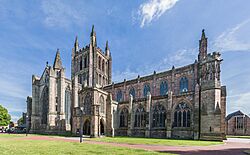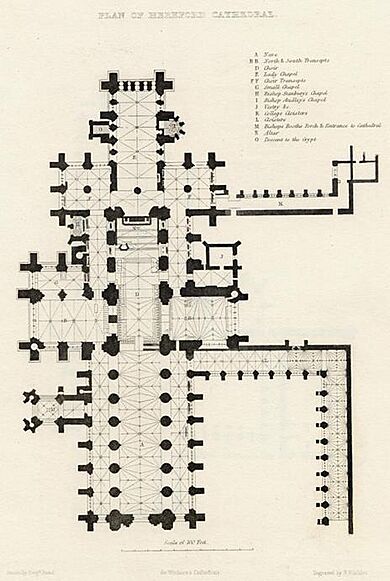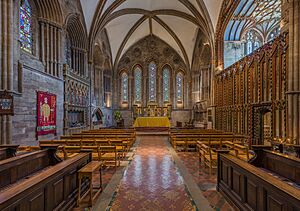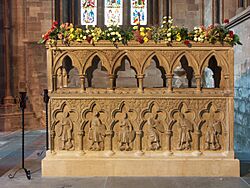Hereford Cathedral facts for kids
Quick facts for kids Hereford Cathedral |
|
|---|---|
| Cathedral of Saint Mary the Virgin and Saint Ethelbert the King |
|

Cathedral from the north-west
|
|
| Lua error in Module:Location_map at line 420: attempt to index field 'wikibase' (a nil value). | |
| Location | Hereford, Herefordshire |
| Country | England |
| Denomination | Church of England |
| Previous denomination | Roman Catholic Church |
| Tradition | Broad church |
| Website | hereford cathedral.org |
| Architecture | |
| Previous cathedrals | 1 |
| Style | Gothic (Early English) |
| Years built | 1079-c.1250 |
| Specifications | |
| Length | 342 ft (104.2m) |
| Nave length | 158 ft (48.2m) |
| Choir length | 75 ft (22.9m) |
| Nave width | 73 ft (22.3m) |
| Width across transepts | 256 ft (78m) |
| Height | 165 ft (50.3m) |
| Nave height | 64 ft (19.5m) |
| Choir height | 62 ft (19m) |
| Number of towers | 1 |
| Tower height | 165 ft (50.3m) |
| Administration | |
| Diocese | Hereford (since 680) |
| Province | Canterbury |
Hereford Cathedral, also known as the Cathedral of Saint Mary the Virgin and Saint Ethelbert the King, is a large church in Hereford, England. It is a Church of England cathedral and the main church for the diocese of Hereford. This historic building is protected as a Grade I listed building.
People have worshipped on this spot since at least the 700s. The current building started being built in 1079. Many parts of the cathedral are from the Norman and Gothic periods.
The cathedral is famous for having the world's largest library of chained books. Its most well-known treasure is the Mappa Mundi, a medieval map of the world made around the year 1300. This map is so important that it's on the UNESCO Memory of the World Register.
Contents
History of Hereford Cathedral
Early Beginnings
The cathedral is named after two saints: St Mary the Virgin and St Ethelbert the King. King Ethelbert was killed in 794 by Offa, King of Mercia. Historians are not sure why this happened.
Legend says Ethelbert's body was brought to the cathedral's location by a monk. Miracles were said to happen at his tomb. Around 830, a nobleman named Milfrid built a stone church there, dedicating it to King Ethelbert.
Hereford became a bishopric (an area led by a bishop) around the 670s. The first stone cathedral stood for about 200 years. In 1056, it was attacked and burned by Welsh and Irish forces. Seven church officials were killed trying to defend it.
Norman Building Period
Hereford Cathedral was in ruins until Robert of Lorraine became bishop in 1079. He started rebuilding it. Later, Bishop Reynelm continued the work. The church was finally finished under Bishop Robert de Betun between 1131 and 1148.
Parts of this original Norman church still exist today. These include the nave (the main part of the church), parts of the choir, and the south transept (the arms of the cross-shaped church). About 50 years after it was finished, Bishop William de Vere added a retro-choir and a lady chapel to the east end.
13th Century Changes
Between 1226 and 1246, the Lady Chapel was rebuilt in the Early English style, with a crypt (an underground room) beneath it. Around the mid-1200s, parts of the choir were rebuilt because the central tower had settled and caused damage.
Bishop Peter of Aigueblanche (1240–1268) started rebuilding the north transept. This work was finished later in the century by Bishop Swinfield, who also built the aisles of the nave.
Bishop Thomas de Cantilupe
Thomas de Cantilupe became Bishop of Hereford after Aquablanca. He was a strong leader who fought for the rights of his church. He even made a powerful lord walk barefoot through the cathedral as punishment!
Cantilupe also got back lands that had been taken by the Welsh king. He was a very dedicated bishop. After he died in 1282, his bones were brought back to Hereford Cathedral. His tomb became a popular place for pilgrimage (religious journeys).
In 1320, 40 years after his death, Cantilupe was made a saint. His family's coat of arms became the symbol for the diocese. A lot of work was done to the cathedral to honor him. This included changes to the north porch. It is also thought that the Hereford Mappa Mundi was created around this time.
Later Additions (14th to 16th Century)
In the early 1300s, the central tower was rebuilt. It has special ball-flower decorations. Around the same time, the chapter house (a meeting room for the clergy) was built. Later, Bishop Thomas Trevenant rebuilt the south end of the great transept.
In the mid-1400s, a tower was added to the west end of the nave. Bishops John Stanberry and Edmund Audley built three chantries (small chapels for prayers). The last additions were made by Bishops Richard Mayew and Charles Booth between 1504 and 1535, who built the north porch. This means the main building of the cathedral took about 440 years to complete!
17th and 18th Century Events
During the English Civil War in the 1600s, Hereford city was captured several times. When the cathedral was taken, it was badly damaged.
In the early 1700s, Bishop Philip Bisse worked to support the central tower. He also had a large altarpiece and an oak screen installed. Instead of fixing the Chapter House, he allowed its stones to be used for changes to the Bishop's Palace.
His brother, Thomas Bisse, helped start the "Music Meeting" in 1724. This event later became the Three Choirs Festival, which is still held today with Worcester and Gloucester.
1786: West Tower Falls
A big disaster happened on Easter Monday in 1786. The west tower of the cathedral fell down. This destroyed the entire west front and part of the nave. The tower looked similar to the central tower, with many ball-flower decorations and lead spires.
James Wyatt was hired to fix the damage. However, he didn't just repair it; he made many changes that were not popular with everyone.
19th Century Restoration
Major restoration work began in 1841, led by Dean Merewether and carried out by Lewis Nockalls Cottingham and his son. The old masonry from the central tower was removed, and the lantern (the part of the tower above the crossing) was strengthened. Much work was also done on the nave and the outside of the Lady Chapel.
After Cottingham's son died in 1854, George Gilbert Scott took over. He worked on restoring the choir until 1863. The cathedral was reopened with special services on June 30, 1863.
The west front was restored again by John Oldrid Scott between 1902 and 1908. James Wyatt's west front, sometimes called "Wyatt's Folly," was replaced with a beautiful new design. This new front honored Queen Victoria's Diamond Jubilee. It includes a stunning stained glass window with seven sections, paid for by the women of the Hereford diocese.
20th and 21st Century Changes
A new library building was built in the early 1990s and opened by Queen Elizabeth II in 1996. In 1967, a large iron choir screen designed by George Gilbert Scott was removed. It was later restored and is now at the Victoria and Albert Museum in London.
From 2010 to 2011, a new Cathedral Green was created with pathways and seating. In 2015, more landscaping and restoration work began, funded by the Heritage Lottery Fund. This work involved reburying thousands of old bodies found in the cathedral's burial plot. Some of these bodies were from the 12th to 14th centuries.
One interesting discovery was a knight who might have been a jousting participant. Another was a person with leprosy, which was unusual for someone to be buried near a cathedral.
Cathedral Leadership
As of May 11, 2022, the main leaders of Hereford Cathedral are:
- Dean — Sarah Brown (since 2021)
- Precentor – Andrew Piper (since 2003)
- Chancellor – The Revd Canon James Pacey
Famous People Connected to the Cathedral
Many important people have been connected to Hereford Cathedral. These include:
- Robert of Gloucester, a historian from 1291.
- Nicholas of Hereford, a leader of the Lollards at Oxford in 1377.
- Polydore Vergil, a famous writer who was a prebendary (a type of church official) in 1507.
- Miles Smith, who helped translate the Authorized King James Version of the Bible.
Cardinal Thomas Wolsey, a very powerful figure in English history, was also connected to Hereford Cathedral. He became a prebendary in 1510 and Dean in 1512.
Cathedral Features
Size and Dimensions
The cathedral is quite large!
- The outside length is about 342 feet (104.2 meters).
- The inside length is about 326 feet (99.4 meters).
- The nave is 158 feet (48.2 meters) long.
- The choir is 75 feet (22.9 meters) long.
- The main transept is 146 feet (44.5 meters) long.
- The nave and choir (including the aisles) are 73 feet (22.3 meters) wide.
- The nave is 64 feet (19.5 meters) high.
- The tower is 140.5 feet (42.8 meters) high, or 165 feet (50.3 meters) with its pinnacles.
The nave has beautiful decorations on its Norman architecture columns and arches. In the south aisle of the nave, there are two 14th-century tombs with statues of unknown church officials. There is also the tomb of Sir Richard Pembridge, which shows the armour of that time.
At the northern entrance, there is a porch and a decorated doorway. Inside, you can see a modern rood screen and a tall central lantern. The Lady Chapel has tall, narrow windows and a vaulted roof. The tomb of Bishop Charles Booth, who built the porch, is on the north side of the nave. On the south side is the Norman font, a large round bowl used for baptisms.
Great Transept and Choir
The north transept was rebuilt in the Decorated period and later restored. It has interesting patterns and pointed arches. The north window has stained glass by Hardman. In this transept is the tomb of Thomas de Cantilupe. It is made of Purbeck marble and has 14 figures of Knights Templars in chainmail armour.
The south transept is believed to be the oldest part of the cathedral, showing some Norman work.
The choir has three Norman sections and is full of beautiful things. The reredos (a screen behind the altar) has five carved sections showing scenes from Jesus's life. Behind it is a carving of Christ with angels and the four Evangelists. Below this is a figure of King Ethelbert. You can also see a small statue of King Ethelbert on the south side of the choir. The Bishop's throne and the choir stalls are from the 14th century and have been restored.
Misericords
The choir stalls have forty 14th-century misericords. These are small wooden seats that flip up, with carvings underneath. They show a mix of mythical creatures, funny figures, and scenes from everyday life. There are also five more misericords in a row of "Judges' Seats."
East Transept
In the north-east transept, there are many old stone fragments. There is also a beautiful tomb made of alabaster and marble for Dean Richard Dawes, who died in 1867. The south-east transept has memorials to several Bishops of Hereford. Here you can also see a statue of John the Baptist and a marble bust. The tomb of Richard Mayew (died 1516) is also here. A doorway in this transept leads to the Vicars' Cloister, which goes to the college where the vicars choral live.
Lady Chapel
The spacious Early English Lady Chapel is built over the crypt and reached by five steps. The five tall, narrow windows at the east end are very special. They are filled with glass by Cottingham, honoring Dean Merewether, who is buried in the crypt below.
In the Lady Chapel are tombs of Joanna de Kilpec and Humphrey de Bohun. Joanna was a generous supporter of the cathedral in the 14th century. On the south side of the Lady Chapel is a chantry built by Edmund Audley at the end of the 15th century. It is pentagonal (five-sided) and has two levels.
Crypt and Library
The crypt is small but interesting because it is Gothic, not Norman. It was once used as a charnel house (a place for bones), which gave it the name Golgotha.
The Hereford Cathedral Library is a chained library. This means its old manuscripts are chained to the shelves. Some of these books have beautiful illustrations in gold and color. Two very valuable books are a unique 13th-century Hereford antiphonary and the Hereford Gospels, a copy of the Gospels that is at least a thousand years old, written in Anglo-Saxon characters. Another treasure is an old wooden reliquary (a container for holy relics).
Hereford Mappa Mundi

One of the cathedral's most famous treasures is the Hereford Mappa Mundi, a map of the world from the late 1200s. It was made by a church official named Richard de la Battayle (also known as Richard de Haldingham or Lafford).
During the time of Cromwell, the map was hidden under the floor of Edmund Audley's Chantry to keep it safe. In 1855, it was cleaned and repaired at the British Museum. It is the largest old map drawn on a single sheet of vellum (animal skin).
The map shows the world as round, surrounded by the ocean. At the top (the east) is Paradise, with its river and tree. Above that is a picture of the Day of Judgment. The map also shows many towns, animals, birds, and fish. Four big cities are shown clearly: Jerusalem, Babylon, Rome, and Troy. Many cathedrals in Britain are also mentioned.
In the 1980s, the cathedral faced money problems, and there was talk of selling the Mappa Mundi. But thanks to large donations from the National Heritage Memorial Fund, Paul Getty, and the public, the map stayed in Hereford. A new library was built to house the map and the chained libraries from the Cathedral and All Saints' Church. This new center opened on May 3, 1996.
Magna Carta
Hereford Cathedral is lucky to have one of only four copies of the 1217 Magna Carta that still exist. It is one of the best-preserved of the eight oldest copies. Sometimes, it is displayed next to the Hereford Mappa Mundi in the cathedral's chained library.
Organ and Bells
On the south side of the choir is the organ, built in 1892 by "Father" Henry Willis. It is considered one of the best organs he ever made. The case for the organ was designed by Scott.
Organists
Some famous organists at Hereford Cathedral include the composers John Bull and John Farrant. George Robertson Sinclair, a friend of composer Edward Elgar, was also an organist here. The current organist is Geraint Bowen.
Bells
Hereford Cathedral has 10 bells located 140 feet (42.7 meters) high in the tower. The largest bell weighs about 1.7 tonnes. The oldest bell in the cathedral is the sixth one, which dates back to the 13th century. These bells are sometimes called the "Grand Old Lady" because they are a unique set.
Burials at Hereford Cathedral
Many important people are buried at Hereford Cathedral, including:
- Robert of Hereford, an early bishop.
- Peter of Aigueblanche, Bishop of Hereford (1240–1268).
- Thomas de Cantilupe, an English saint and Bishop of Hereford (1275–1282).
- Thomas Charlton, a Lord and Bishop of Hereford (1327–1344).
- Gilbert Ironside the younger, Bishop of Hereford (1691–1701).
- William Felton (1713–1769), a composer.
Other Buildings Around the Cathedral
Between the two cloisters (covered walkways), the Bishop's and Vicars', are the remains of the Chapter House. It was damaged during the 1645 war. The Bishop's Palace, the Deanery, homes for the canons, and the cathedral school are all close by. The college, where the vicars choral live, forms a pretty quadrangle.
Images for kids
See also
 In Spanish: Catedral de Hereford para niños
In Spanish: Catedral de Hereford para niños
















